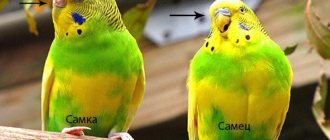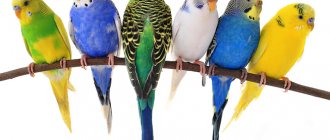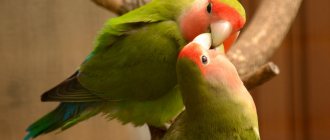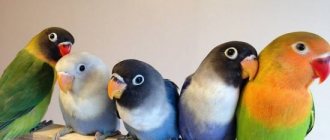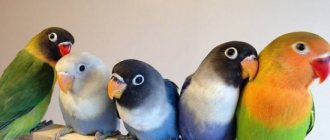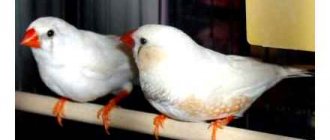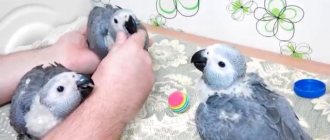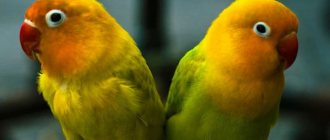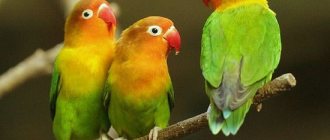Lovebirds are the most popular bird species to keep at home. They are distinguished by their small size, beautiful color and cute behavior. When choosing a parrot, it is important to pay attention to both the sex and age of the individual, because the bird’s further behavior, its ability to reproduce and the length of its life in the family depend on this. But how to distinguish lovebirds when buying? Let's look at the secrets of determining the age and sex of birds in this article.
How to find out age
Not only an experienced breeder can determine how old a bird of paradise is. There are several simple principles on how to find out the age of a bird. When purchasing, it is important to pay attention to the appearance of the parrot: this will allow you to choose a young individual. Sellers in pet stores most often know the exact date of chicks' departure from the nest: this is enough to determine the days of life of individuals. If it is impossible to find out this moment, you can determine how old the parrot is yourself during the examination of the pet.
According to the shape and size of the head
Lovebirds grow quickly. Within a month they reach the size of adults. It is for this reason that determining the age of a bird by the shape of its head is an impossible task. This characteristic can help determine gender: girls have larger heads than boys.
By the eyes
Eye examination is one of the most popular ways to determine the age of a lovebird. Young individuals have a peculiar eye structure. In the first weeks of life, lovebirds have enlarged pupils: they almost completely cover the whites. They appear to have black eyes. The pupils become smaller over time. If in front of you is a parrot with normal-sized pupils, it is already an adult.
By the beak
Young parrots have a small and thin beak, while in adults it is massive and strong, often curved. Young parrots have darker skin over their beaks. This area is called the "cere". After a few months, it brightens, merging with the overall color. Often young lovebirds have tissue separation on their beaks. This is caused by the growth of new tissue over the beak of babies. During this period, birds need proper and regular nutrition, as well as attention from their owners. In 99% of cases, tissue renewal occurs without complications.
By paws and claws
A convenient and simple method to determine the age of a lovebird is to examine the bird’s legs. In chicks, the skin over the claws is soft and light. With age, it darkens due to the development of scales. Birds' claws grow gradually, but it is difficult to determine their age, because after a month they reach a standard size.
By appearance
Birds, like people, change every year. When choosing a pet, you should pay attention to its plumage, color, pupil size, head and paws. This will allow you to choose a pet of the age you need. Remember that young birds have brighter colors and are more active.
By color
Young lovebirds have brighter and shinier feathers. They have a hint of gray on their wings and neck. The overflow effect disappears already at six months of age. In adult parrots, the color is uniform and more matte. Lovebirds, when reaching adulthood, become almost completely green. A yellow or red tint in parrots after a year is noticeable on the throat, neck, head and back. The color differs not only in young and adult individuals, but also in males and females.
Where do lovebirds live?
Photo: Lovebirds in Africa
The lovebird in the wild is found mainly in tropical Africa and Madagascar. However, they are largely absent from the dry regions of the Sahel and Kalahari, and from much of South Africa.
There are nine species of this bird:
- the collared lovebird, scientifically named A. swindernianus, is widespread in equatorial Africa;
- The masked lovebird A personatus is a species native to Tanzania;
- Liliana's lovebird (Agapornis lilianae) is endemic to eastern Africa;
- rosy-cheeked lovebird (A. roseicollis) are located in southwestern Africa. They inhabit the northwestern corner of South Africa, across the western half of Namibia and into the southwestern corner of Angola. The area around Lake Ngami is rapidly becoming colonized by A. roseicollis due to natural range expansion;
- Fischer's lovebird (A. fischeri) lives at altitudes from 1100 to 2000 m. It is found in Tanzania, in central eastern Africa. They are also known in Rwanda and Burundi. They are most often seen in the northern regions of Tanzania - Nzege and Singida, Serengeti, Arusha National Park, on the southern edge of Lake Victoria and on the Ukerewe Islands in Lake Victoria;
- the black-cheeked lovebird (A. nigrigenis) has a relatively limited range in southwestern Zambia;
- The red-faced lovebird (A. pullarius) is native to a wide range of countries in Africa, including Angola, Congo, Cameroon, Chad, Guinea, Togo, Gabon, Ghana, Guinea, Mali, Niger, Kenya, Nigeria, Rwanda, Sudan, Tanzania, Ethiopia and Uganda. It is also an introduced species in Liberia;
- black-winged lovebird (A. taranta). The natural habitat extends from southern Eritrea to southwestern Ethiopia, and they typically live in either high plains or mountainous areas;
- The grey-headed lovebird (A. canus) is native to the island of Madagascar and is also known as the Madagascar lovebird.
They inhabit savannas and dry forests dominated by trees such as Commiphora, Acacia, Baobab and Balanites. In addition, lovebirds can live in arid areas, but near permanent standing water. The habitats of some species include the edges of deserts and forested areas, as well as poorly wooded areas if only a few trees are near water. Preferred regions range from sea level to altitudes above 1500 m.
How to find out gender
Experienced breeders can determine the sex of a bird at first glance. There are 6 ways to distinguish a boy from a girl lovebird.
According to the shape of the head
Male parrots have smaller heads than females. Males have a lower forehead and an angular nape, as well as a flatter head. Many people call this shape “cut”. Females, in turn, have a voluminous but short head.
By the beak
How to distinguish a female from a male? Examine the parrot's beak. In girls it is thin and small, boys have a thick and wide beak. Sometimes males are distinguished by their colored beaks: a combination of yellow and orange colors. Females have monochromatic beaks: yellow, white or brown.
Along the pelvic bones
You can find out the sex of a chick by the size of its pelvic bone. This procedure must be carried out very carefully, since parrots have fragile bones. Inspection can be difficult due to the bird's aggressive reaction to touch. Males and females may spit or scream when their territory is invaded.
How to palpate the pelvic bones? It is necessary to place the bird on your hand with its belly up. It is necessary to palpate the pelvic bones gently. Place your fingers on the bird's body, feeling for any protruding bones. It is necessary to determine the distance between them. In boys, the gap between the pelvic bones will be less than a centimeter, and in girls - 1-2 cm.
It is also worth paying attention to the width of the pelvic bones. Females have a wider pelvis because they lay eggs. During laying, the distance between the pelvic bones of females increases to ensure free release of eggs.
To size
The size of the bird depends on the sex of the individual. Lovebirds can be distinguished within a couple of weeks after birth. Females have a small body, but this cannot be seen with the naked eye. Boys and girls of the same age are practically the same in size.
By color
Experts use another way to distinguish between male and female lovebirds: inspection of the feathers. The color of a bird's feather indicates not only its age, but also its gender.
Lovebird boys have bright and rich colors. They are distinguished by shiny green, yellow or red feathers. Females have lighter plumage. The pattern is also different: for girls it is chaotic. This difference is explained by the fact that males use bright colors to attract the attention of females.
By behavior
The behavior of males and females has a lot of differences. Lovebird girls pay more attention to their appearance: they often wash their feathers and look in the mirror (if there is one in the cage). They also love to scold their partners. If there are 2 parrots in front of you, one of which is constantly pecking or grumbling at the other, know that the female is screaming.
Girls of this species are more thrifty: they bring materials for building a nest, they can hide food and other things that they think are important. There is an interesting test for checking the sex of a bird: put a napkin next to the cage - the girl will definitely crush it to build a nest.
Vivid differences between individuals of both sexes appear during the mating period. Boys at this time behave radically differently than in everyday life. They rub against the perches, pester the female, and may scream.
When do sexual characteristics appear?
Buying a lovebird is a responsible and slightly risky undertaking. The difficulty is that instead of a boy or girl, you can buy a bird of the opposite sex. This is fraught with consequences, especially if there is already one parrot at home. It is easier to determine the female or male of lovebirds when they are older, when visible differences begin to appear. Another nuance is their behavior: the boy behaves calmly, but the girl is afraid of people and often “preens.”
Attention! It is better to buy lovebirds as adults, so as not to miscalculate the gender.
The easiest way is to find an already formed pair living in a cage together. True, in this case the seller may not say anything about their age. The bottom line is that in order to purchase a lovebird of the desired sex, you should always carefully examine its appearance.
Male or female: looking for differences
Choosing a name is another task that requires knowledge of how to determine the sex of a lovebird. Parrots of this species are not inclined to imitate human speech, but are able to remember their nickname and respond to it. An absurd situation may arise when a parrot, which was thought to be a girl, turns out to be a boy.
External manifestations that are looked at when establishing gender:
Each sign separately does not guarantee correct sex determination. All features must be taken into account together.
Note the difference in size
Among lovebirds, males are usually larger than females. To use this trait to determine sex, you need to compare two or more parrots. Perhaps the bird with the most impressive dimensions will be a male.
The method is characterized by low accuracy, because each individual is individual. There are plump girls and fragile boys, and there is no guarantee that all the birds are of the same age. The older the chick, the fluffier its feathers and the greater its muscle mass.
Studying the shape of the head
Many people try to determine the sex of lovebirds by the outline of their heads. If you look in profile, the skull of males appears angular, while that of females appears rounded. The back of the male's head is flattened, his forehead is low, the transition between the crown and the beak is short. The girl's head seems compact and neat compared to the boy's.
Looking at the beak
A relatively reliable sign by which sex can be determined is the shape and color of the beak. In a male it will be convex and wide at the base. The female's beak is rather narrow and slightly flattened. The mandible is approximately the same in birds of both sexes.
The color of the male's beak is more saturated: bright red in the Fisher's lovebird, pink in the masked lovebird. Females are inferior here too. Their beaks are painted in light colors: beige, pale orange, faded yellow.
Feeling the pelvic bones
On the physiological side, there are features that are characteristic only of females. To bear and lay eggs, mobility of the bones under the abdomen is necessary. In order for a bird to perform its natural function, the pelvic bones must diverge to a width of at least 1 cm.
Try to calculate your pelvic size yourself:
On a note! If the experiment fails, the female can be detected by the method of landing. The female sits on the stick, spreading her legs wide. At the same time, she leans forward slightly to maintain her balance.
Comparing feather colors
The plumage of lovebirds is bright and contrasting. Depending on the type, up to 5–6 different shades may be present on the body. The female and male of the same variety are colored in the same color scheme. However, there are nuances that allow us to draw a conclusion about gender. Female black-winged lovebirds lack the red color on their heads. Red-faced girls have orange feathers on their heads and green feathers with a yellow tint on their bodies. In general, the plumage of females is not as intensely colored as that of males.
Observing behavior
Sometimes, to distinguish a boy from a girl, it is enough to follow the birds for a couple of days to understand which one is which.
The male sex feels its superiority, which is manifested in proud calm. He does not pay attention to the behavior of the girl, who sometimes grumbles and tries to give orders. The male does not lose self-control in quarrels, and after reconciliation he continues to take care of his partner.
This is interesting! Females, like women, love to dress up. Twigs, straws, pieces of paper that fall into the cage are immediately used to decorate the tail and wings.
You can find out the sex of a lovebird by external signs no earlier than he is six months old. Upon completion of the juvenile molt, the bird acquires permanent coloration and develops habits characteristic of one sex or another. If the purpose of keeping parrots is not breeding, then there is little point in specifying the gender. Both male and female lovebirds are equally good.
Source
What do lovebirds eat?
Photo: Lovebirds
They prefer to search for food on the ground. They eat a wide variety of foods, foraging primarily on seeds but also eating fruits such as small figs. They do not migrate, but travel long distances to find food and water when they are in difficulty. During harvest time, lovebirds flock to agricultural areas to eat millet and corn. Birds need water daily. At abnormally high temperatures, they can be found near ponds or any water sources where birds can receive liquid several times a day.
In captivity, the typical basic diet for lovebirds is a fresh mixture (with dried fruits and vegetables) of excellent quality, combining a variety of seeds, grains and nuts. Ideally, the base mix should contain or be supplemented with approximately a 30% proportion of any bio/organic (naturally colored and flavored and no preservatives) and/or any natural (naturally colored, flavored and preserved) granules.
The main products of the base mixture should be:
- cereals;
- fruits;
- greenery;
- weeds;
- legumes;
- vegetables.
The ratio of granules and fresh products should be adjusted depending on the composition of the granules, which should include varieties of amaranth, barley, couscous, flax, oats, rice (basmati, brown rice, jasmine rice), wheat, corn. Edible flowers: carnations, green onions, dandelions, fruit tree flowers, hibiscus, honeysuckle, lilac, pansies, sunflowers, tulips, eucalyptus, violets.
Fruits with their seeds: all varieties of apples, bananas, all varieties of berries, all varieties of citrus fruits, kiwi, mango, melon, grapes, nectarine, papaya, peach, pears, plums, carom. Vegetables are also healthy for lovebirds, including zucchini, roasted zucchini seeds, beets, broccoli, carrots, cucumbers, all types of cabbage, beans, peas, parsnips, all types of peppers, all types of pumpkin, sweet potatoes, turnips, yams, zucchini .
Now you know how to keep lovebirds at home. Let's see how they live in the wild.
